Publication Snapshots
Nuclear position and local acetyl-CoA production regulate chromatin state (Willnow and Teleman, Nature 2024)
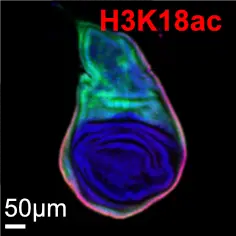
Although neighboring cells in an epithelial tissue all have the exact same genotype, it is well known that they can have different cell identities resulting from differential gene expression. Indeed, signaling pathways such as BMP, Wnt or Notch signaling, set up patterns of gene expression in tissues, which can easily be seen by antibody staining or by in situ hybridization, and these patterns are important for specifying cell fate. What about metabolism? Is the metabolism of neighboring cells in a tissue the same or different? We look at that question in this study, and discover that the metabolism of neighboring cells can differ significantly. We find that cells on the rim of many epithelial tissues in Drosophila, such as the wing disc, have high fatty acid beta oxidation. This causes rim cells to have have levels of acetyl-CoA, which impacts histone acetylation and gene expression. This is an example how cell metabolism can have an instructive role in regulating gene expression and cell fate.
G6PD and ACSL3 are synthetic lethal partners of NF2 in Schwann cells (Kyrkou et al., Nature Communications 2024)
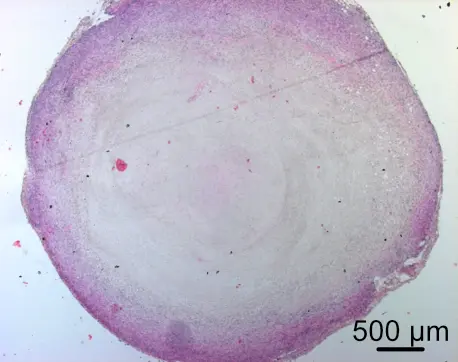
Neurofibromatosis Type 2 is a genetic, cancer pre-disposition disease caused by loss of the NF2 gene, leading to recurrent Schwann cell tumors, meningiomas and ependymomas. Unfortunately, there are few drug option available for treating NFII. Here we performed a genome-wide screen and identified new pharmacological targets for NFII therapy.
Fitness trade-offs incurred by ovary-to-gut steroid signaling in Drosophila (Ahmed et al., Nature 2020)
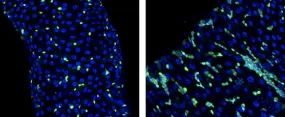
Sex hormones affect homeostasis and disease progression in reproductive organs. However, it is not well understood whether this sexual dimorphism in circulating hormones can also impart differences in the physiology of non-sex organs such as the gut. Here, we show that the ovary-derived steroid hormone 20-hydroxyecdysone (20HE) in Drosophila females drives intestinal stem cell proliferation, leading to larger guts. Exposing males, which have low 20HE levels, to 20HE in their food is sufficient to instate female growth phenotypes to the gut, suggesting that the circulating levels of 20HE are a strong determinant of ISC behavior. However, this proliferation advantage normally given to female ISCs comes at the expense of faster gut deterioration during aging and higher tumor predisposition. This work provides a mechanism that connects elevated levels of sex steroids to physiology and pathology of non-sex organs. Owing to the interesting parallels between Drosophila and mammals, more detailed analysis of sex steroid effects on the human gut should be relevant and worthwhile.
Selective 40S footprinting reveals cap-tethered ribosome scanning in human cells (Bohlen et al., Molecular Cell 2020)

Nearly 50% of all human mRNAs contain at least one uORF (upstream Open Reading Frame) in front of the main ORF and many of these are translated in vivo. Upon terminating uORF translation, ribosomes need to reinitiate translation on the main ORF in order to express the encoded protein. This mechanism is not well understood. When translating the uORF, most initiation factors (eIFs) are thought to fall off the ribosome. One open question is how new eIFs are re-recruited to the ribosome after uORF translation to enable translation of the main ORF downstream.
We developed a technique which we call 'selective 40S footprinting' to visualize initiating 40S ribosomes on endogenous mRNA in vivo and to reveal the positions on the mRNAs where eIFs join the ribosome and then leave again. This revealed several fundamental observations about translation initiation in human cells. Surprisingly, contrary to our expectation, we found that eIFs do not fall off the ribosome right away when it starts translating. Instead, the ribosome retains eIFs for roughly 12 elongation cycles. Hence on short uORFs, this means ribosomes are still eIF-associated when they terminate, and hence can restart a new round of translation on the same mRNA. We think selective 40S footprinting will be a useful tool to study translation initiation mechanisms in vivo on endogenous mRNAs.
Cdk4 and Cdk6 Couple the Cell-Cycle Machinery to Cell Growth via mTORC1 (Romero-Pozuelo et al., Cell Rep 2020)
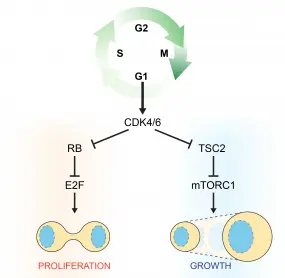
Cell growth is coupled to cell-cycle progression in proliferating cells but the underlying molecular mechanisms are not well understood. It is known that CyclinD-Cdk4/6 contributes to cell cycle progression. We show now that CyclinD-Cdk4/6 simultaneously activates cell growth in mammalian cells via activation of mTORC1, the major regulator of cell growth.
Our findings also provide new insights into the mechanism of the Cdk4/6 inhibitors palbociclib and abemaciclib which are clinically used to treat breast cancer. Cdk4/6 inhibition acts on cell proliferation and growth via at least two parallel pathways: by blocking cell-cycle progression and by inhibiting mTORC1. This could provide an explanation why combined inhibition of Cdk4/6 with mTORC1 inhibitors is an effective strategy for blocking proliferation of ER-positive breast cancer cells, because cells would need to develop resistance to both drugs to reactivate proliferation.
Gene expression atlas of a developing tissue by single cell expression correlation analysis (Bageritz et al., Nature Methods 2019)
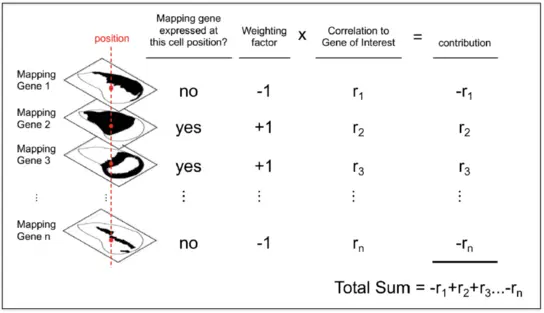
This study in close collaboration with the Boutros lab provides a gene expression map of the Drosophila wing disc.
The map was developed using a new method for analyzing single cell RNA sequencing data based on gene expression correlations rather than cell mapping.
The Drosophila wing disc is an important model system for studying tissue growth, pattern formation, epithelial morphogenesis, intercellular signaling, cell competition, and tissue biophysics.
The challenge with the wing disc is that it is composed of many undifferentiated, pluripotent cells. In addition, the transcriptome coverage of current single-cell RNA sequencing approaches does not allow to confidently determine the tissue location of a sequenced cell based on its expression of known genes.
We therefore developed a new method that uses a cross-correlation matrix between known mapping genes and all genes in the genome to generate expression maps. We thereby discover 824 genes with spatially restricted expression patterns. The approach identifies both known and new clusters of genes with similar expression patterns.
As proof of concept for the functional correlation of genes in a cluster, we find that the previously uncharacterized gene CG5151, which correlates with Wnt4 and wg gene expression, indeed regulates Wnt signaling.
The novel method is a useful tool for generating expression atlases of undifferentiated tissues during development.
Dietary stearic acid regulates mitochondria in vivo in humans (Senyilmaz-Tiebe et al., Nature Communications 2018)
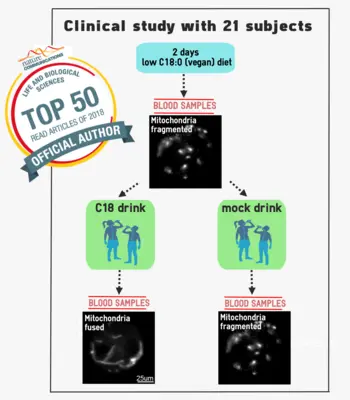
Our previous work identified the metabolite stearic acid (C18:0) as a signaling molecule that regulates mitochondrial morphology and function in fly and human cells in culture. We found that when C18:0 is added into the medium of cells in culture, this leads to activation of a signaling pathway that starts with post-translational modification of a cell surface receptor, TfR1, and leads to activation of Mitofusin 2 and mitochondrial fusion. In this paper we conducted a clinical study to test whether this pathway is also activated in humans upon eating C18:0. Indeed, we find that 3 hours after eating C18:0, the mitochondria of our white blood cells become more fused. This indicates that the human body senses and reacts to the levels of C18:0 in our diets. In contrast, palmitic acid (C16), the most abundant fatty acid in our food, does not activate a mitochondrial response like C18:0 does. Interestingly, epidemiological studies showed that C16:0 increases the risk for cancer and cardiovascular risk whereas C18:0 reduces both. This work was done in collaboration with the lab of Peter Nawroth at the Heidelberg University Hospital and was funded by an ERC Consolidator Grant.
This publication is in the Top 50 Nature Communications life and biological sciences articles published in 2018.
DENR•MCTS1 heterodimerization and tRNA recruitment are required for translation reinitiation (Ahmed and Schleich et al., PLOS Biology 2018)
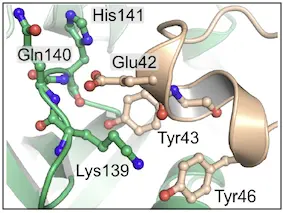
Usually eukaryotic ribosomes translate only a single Open Reading Frame on an mRNA and then dissociate from the mRNA. In some cases, when there is a short upstream Open Reading Frame (uORF) that precedes the main Open Reading Frame, ribosomes can translate the uORF, terminate translation, and then undergo a poorly understood process called ‘translation reinitiation’ whereby they resume scanning for another AUG inititation codon, and then translate the main Open Reading Frame. The molecular functions required for translation reinitiation are not known. We previously showed that two non-canonical initiation factors DENR and MCTS1 promote translation re-initiation. To get a deeper molecular understanding of how DENR and MCTS1 work, in collaboration with the lab of Irmi Sinning at Heidelberg University, we generated a 2.1 Å high resolution crystal structure of MCTS1 bound to the DENR minimal binding domain (N terminal amino acids 24-51). This allowed us to identify individual amino acid residues in DENR and MCTS1 important for heterodimerization and for tRNA binding. Importantly, by mutating these specific amino acid residues, we discover that the DENR•MCTS1 complex needs both functions, heterodimerization and tRNA binding, to promote translation re-initiation in vivo. This thereby identifies for the first time two molecular functions needed for translation reinitiation.
Elevated levels of the reactive metabolite methylglyoxal recapitulate progression of Type 2 Diabetes (Moraru et al., Cell Metabolism 2018)

Several studies have shown that type 2 diabetes progresses even if patients are under optimal glycemic control. This suggests that insulin resistance and hyperglycemia are not the root causes for the disease, and raises the question of the underlying molecular changes that drive type 2 diabetes initiation and progression. Previously it was shown that type 2 diabetes patients have elevated levels of methylglyoxal (MG), a reactive metabolite that forms adducts on proteins and alters their function. In this study we find that Drosophila knockout animals that are impaired in MG detoxification have elevated endogenous MG levels and progressively developed insulin resistance, obesity and hyperglycemia, the core characteristics of type 2 diabetes. This suggests elevated MG can recapitulate some of the core aspects of diabetes in this model organism, raising the possibility that altered MG production or detoxification could be a cause of type 2 diabetes. Future work will be needed to see if this also applies to humans.
DENR•MCT-1 Promotes Translation Reinitiation Downstream of uORFs to Control Tissue Growth (Schleich et al., Nature 2014)
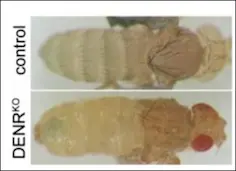
DENR and MCTS1 are oncoproteins that interact physically with each other and have been linked to neurological disorders and to cancer. Although DENR has a protein domain suggesting a role in mRNA translation initiation, the molecular functions of DENR and MTCS1 were not known. To understand the function of DENR, we generated DENR knockout Drosophila. These knockout flies die due to impaired proliferation of abdominal epithelial cells. Interestingly the phenotypes of DENR knockout flies are not observed when general translation is impaired, suggesting DENR and MCTS1 might regulate translation of a specific subset of mRNAs involved in cell proliferation.
The analysis of mRNAs that require DENR for efficient translation revealed that DENR-MCTS1 specifically facilitate the expression of mRNAs with upstream open reading frames (uORFs) that have strong Kozak sequences (stuORFs). In Drosophila, these are roughly 200 mRNAs that code for regulatory proteins and kinases involved in cell proliferation and neurobiology.
uORFs are located in the 5´untranslated region of mRNAs (5 ´UTR). Many eukaryotic transcripts (>50% in human and mouse cells) have uORFs that precede the initiation codon of the main ORF. If the uORF has a strong Kozak sequence, the scanning ribosome (coming from the 5´ cap) will select the start codon of the uORF for translation initiation. In order to allow translation of the main downstream ORF, the ribosome needs to terminate translation of the uORF and then re-initiate translation. This process likely requires recycling of all translation initiation components and re-recruitment of an initiator tRNA. Our findings showed that DENR-MCT1 specifically promote this translation reinitiation process. These findings suggested a new control system regulating the translation of a specific set of mRNAs via DENR-MCT1.
Regulation of TORC1 in response to amino acid starvation via lysosomal recruitment of TSC2 (Demetriades et al. Cell 2014)

The kinase mTORC1 is one of the main regulators of cell growth. It does so by activating anabolic processes such as protein biosynthesis. For this reason, cells needs to make sure that amino acids, the necessary building blocks of proteins, are present for mTORC1 to be active. It was already known that the presence of amino acids causes mTORC1 activation. Our study showed for the first time that the absence of amino acids leads to active inhibition of mTORC1 activity.
Get in touch with us
